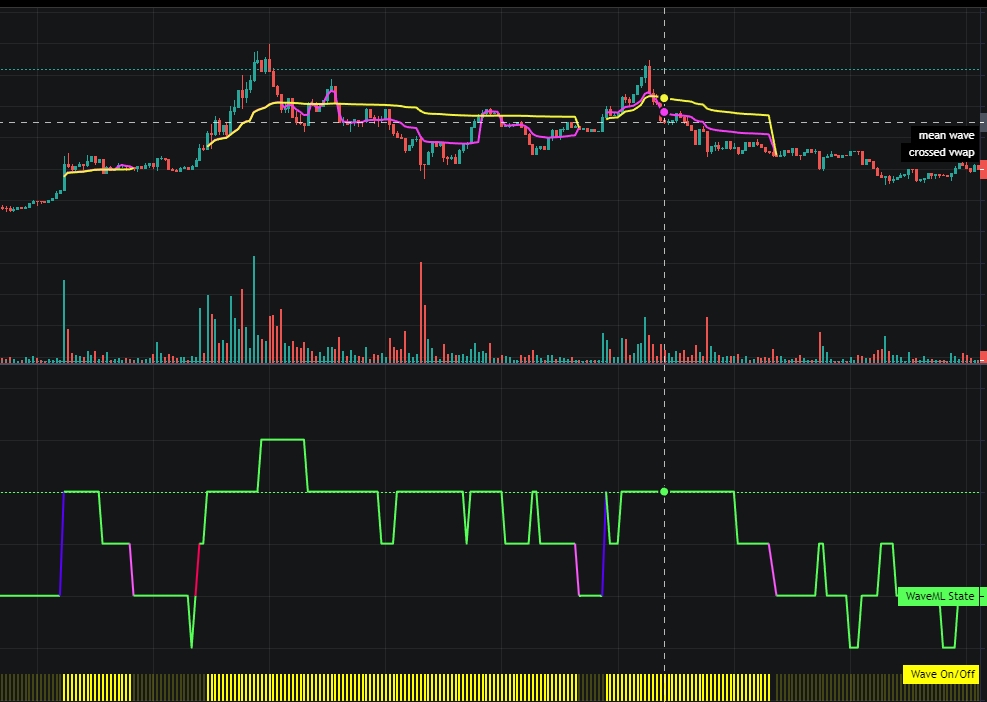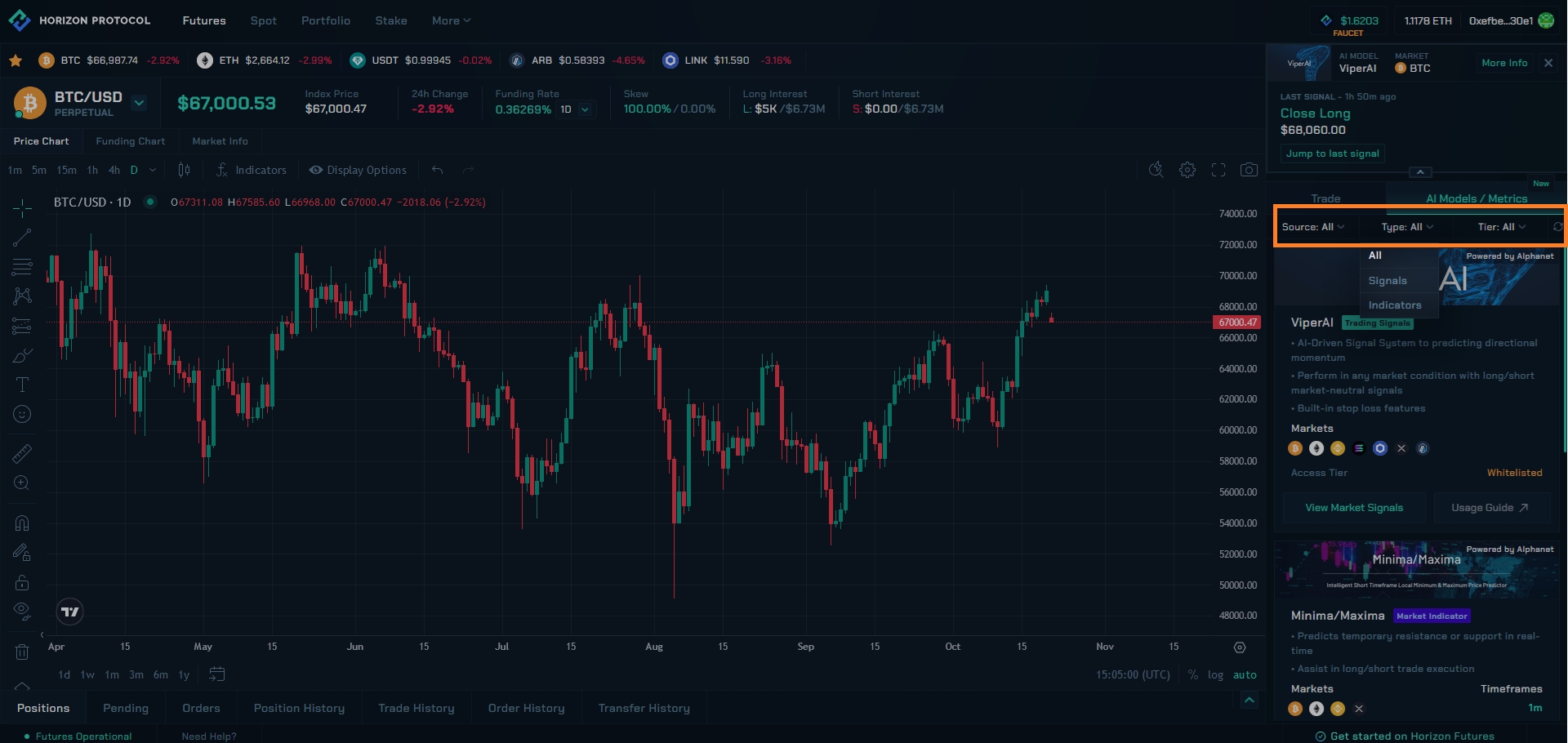WaveML
Navigating Market Trends with WaveML
1. Introduction
Learn about WaveML, a powerful AI tool that tracks market trends and uncovers inefficiencies for more informed trading decisions.
WaveML allows traders to identify potential market moves and capitalize on directional trades. Whether you're new to trading or a seasoned professional, WaveML can deepen your understanding and refine your trading approach.
2. Setting Up & Accessing WaveML
Step 1: Accessing WaveML
Connect Your Testnet Wallet: To start using WaveML, connect your wallet to our DApp on the Arbitrum testnet. Once connected, you'll be directed to the trading dashboard. Please note that to cover gas fees, you'll need Arbitrum Sepolia testnet ETH.

Adding and Removing the WaveML Indicator: To enable the WaveML indicator, navigate to the “AI Models” tab, scroll down to “WaveML,” and click on “Add to Chart.” To remove the indicator, simply click the small “X” next to the indicator's name located below your main chart.

3. Understanding WaveML
WaveML is composed of two key elements: the WaveML State and the Wave On/Off Panel. These elements play a crucial role in identifying short-term structural changes and trend continuations in the market, and will help identify trade opportunities arising from market inefficiency.
WaveML State
This refers to the model’s current interpretation of the market based on wave phases. The state changes according to market movements, and traders can use these transitions to gauge when a trend may be strengthening or weakening. Key transitions between phases often trigger new entry/exit signals.
WaveML State operates through wave phases that help traders interpret market behavior and identify opportunities arising from market inefficiencies. Here’s how to read the different wave phases:
Inefficient Transition (Green to Red): This phase occurs when the WaveML State climbs progressively through phases (e.g., 1 → 2 → 3). It represents a market state change that typically exposes inefficiencies. This transition pattern is a strong signal for a directional trade entry, as it indicates a shift in the market.
Efficient Transition (Green to Purple): This phase involves a more efficient transition, where the WaveML State jumps directly from states [0, 1, 2] to [4, 5]. It signals a fast directional move, but caution is advised due to the possibility of a sharp reversal or increased volatility in the opposite direction.
Continuation (States 3 → 4, Bright Yellow On): When the WaveML State transitions from State 3 to State 4, marked by the bright yellow phase, it often indicates a continuation of the current trend. This phase suggests that the current market momentum is likely to persist, and traders can use this as a solid entry point. It is advisable to validate this signal by combining it with other indicators, such as WaveVWAP, to confirm the trend direction and enhance trading decisions.
Additionally, when the WaveML State transitions from green to pink, it may signal the end of the current trend wave, suggesting an opportunity to exit positions.

Wave On/Off Panel
This panel serves as a visual indicator that reflects the market’s trend status. When the market is in a trending phase, the panel remains darker. However, as the market exits the trend and the WaveML State transitions from green to pink, the Wave On/Off Panel switches to a lighter mode, signaling the end of the trend wave.
WaveVWAP (Volume-Weighted Average Price)
WaveVWAP is a key component of WaveML, serving as a dynamic support or resistance level during active wave phases to help traders interpret trend direction and price momentum. By understanding how WaveVWAP interacts with price, traders can improve precision in timing trade entries and exits.
WaveVWAP Calculation WaveVWAP(yellow) is a variation of the traditional Volume-Weighted Average Price (VWAP), which represents the average price of an asset during a specific time period, weighted by traded volume. WaveVWAP initiates its calculation three minutes before the market transitions to the Wave On phase and continues until the wave ends. This timing refinement is based on the concept of regime filtering and provides traders with insights into market momentum from both slow and fast dimensions.
Dynamic Support/Resistance Use WaveVWAP as a support or resistance marker to identify levels where price may bounce or reverse. When the price is above WaveVWAP, it may indicate bullish momentum, while trading below it may signify a bearish trend. The relationship between the VWAP lines and OHLC is complex and depends on market conditions, such as noise or volatility. A single direction cannot fully determine the trend, combining WaveVWAP with WaveML State transitions and use technical indicators like RSI can help enhance precision for trade entries and exits, offering a more comprehensive view of the market’s current phase.
WaveVWAPCross WaveVWAPCross occurs when the WaveVWAP crosses the average of the OHLC (Open, High, Low, and Close) prices, visually marked in a pink line on the chart. This crossing suggests a potential trend reversal or a shift in market direction. The specific relationship between the WaveVWAP(yellow), OHLC, and WaveVWAPCross(pink) can be summarized as follows:
Trend Signal: The crossing between the WaveVWAP and OHLC often signals a possible end to the existing trend due to market volatility. While WaveVWAP can act as a dynamic support or resistance line, its crossings with OHLC values often indicate shifts that traders may interpret as opportunities for trade entry or exit.
Market Noise and Trend Reversals: Given market noise, the WaveVWAP and OHLC cross could signify a temporary end to a prior trend. For short-term decisions, traders may view the WaveVWAPCross as a sign of increased volatility or market direction change. However, the direction of movement following the cross depends on market context, not a predefined direction.
Trade Planning with WaveVWAP and WaveML
By observing how WaveVWAP interacts with the WaveML State, traders can plan more precise trades:
Wave On/Off State: When the market is in the Wave On phase, represented by darker tones, it is more directional and volatile, with the WaveVWAP indicating potential reversal points within this active trend.
WaveVWAPCross Interpretation: The pink cross between WaveVWAP (yellow) and OHLC can help to time entries or exits by highlighting possible trend shifts, yet the direction post-cross depends on additional signals within WaveML and other indicators like WaveVWAP in dynamic support or resistance mode.
4. Interpreting and Using the Signals
Using WaveML for Better Trading Decisions
When utilizing WaveML, consider these approaches:
Trend Confirmation: Use technical indicators like RSI to validate identified trends.
Watch for End of Trend: A shift from green to pink in the WaveML State indicates a potential end to the current trend, suggesting an exit point.
5. Risk Management
Risk Management Techniques
Managing risk is key to successful trading:
Dynamic Support and Resistance: Treat the WaveVWAP as dynamic support/resistance, and plan trades accordingly.
Stop-Loss Settings: Incorporate stop-loss orders to protect against rapid market changes.
6. Filtering Options
Using Dropdown Menus The AI Models interface features three dropdown menus to help you filter indicators effectively:
Sources: Choose from All, AI-Based, or Classic.
Types: Filter by All, Signals, or Indicators.
Tiers: Select from All, Free, Pro, or Whitelisted.

7. Disclaimer
Trading Disclaimer
Trading involves risks, and the past performance of any AI models does not guarantee future results. Horizon Protocol is not liable for losses incurred while using these indicators. Traders should be responsible for their own trading decisions and risk management strategies.
8. Next Steps
What’s Next?
Now that you’re familiar with the WaveML model, it’s time to put it to the test! Don’t forget to get whitelisted for our testnet if you haven’t already. Simply fill out this survey to be among the first to test our cutting-edge AI tools.
For more insights, updates, and to connect with fellow traders, we invite you to join our community on Telegram and Discord. Stay up-to-date with the latest features and share your experiences with others in the Horizon Protocol community!